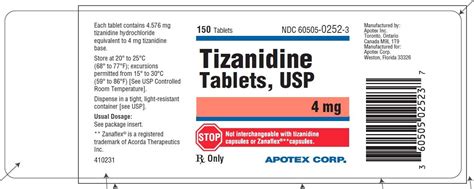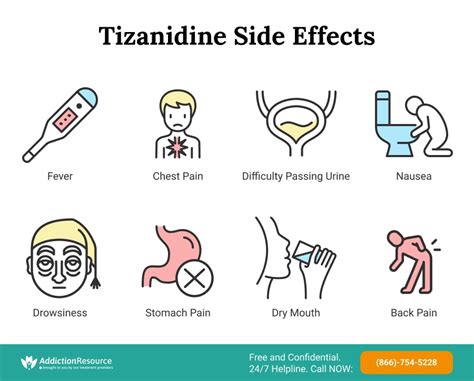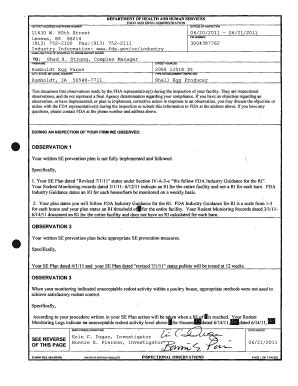Intro
Tizanidine hydrochloride, commonly known by its brand name Zanaflex, is a medication that has been widely used to treat muscle spasms caused by conditions such as multiple sclerosis, spinal cord injuries, and stroke. The drug belongs to a class of medications known as alpha-2 adrenergic agonists, which work by stimulating certain receptors in the brain and spinal cord to produce a relaxing effect on muscles. In this article, we will delve into the specifics of tizanidine hydrochloride 4mg, including its uses, benefits, side effects, and how it works.
The importance of managing muscle spasms cannot be overstated. Muscle spasms can significantly affect an individual's quality of life, causing pain, discomfort, and limiting mobility. Effective management of these spasms is crucial for improving the patient's ability to perform daily activities and enhancing their overall well-being. Tizanidine hydrochloride 4mg has emerged as a valuable treatment option for patients suffering from muscle spasms, offering a potential solution to alleviate these symptoms and improve patient outcomes.
Muscle spasms are a common symptom in various neurological conditions. They can occur suddenly and may be severe enough to cause significant pain and disability. The underlying cause of muscle spasms in these conditions can vary, but the end result is often the same: reduced mobility and increased pain. Tizanidine hydrochloride 4mg is specifically designed to address this issue by providing a targeted therapeutic effect that helps to relax muscles and reduce spasm frequency and severity. By understanding how tizanidine hydrochloride works and its benefits, patients and healthcare providers can make informed decisions about its use in managing muscle spasms.
How Tizanidine Hydrochloride Works

Benefits of Tizanidine Hydrochloride 4mg
The benefits of tizanidine hydrochloride 4mg are multifaceted. First and foremost, it provides effective relief from muscle spasms, which can significantly improve a patient's quality of life. By reducing muscle tone and spasms, tizanidine hydrochloride 4mg can help patients to regain mobility and perform daily activities with greater ease. Additionally, the drug's ability to reduce pain associated with muscle spasms can lead to improved sleep quality and overall well-being. The benefits of tizanidine hydrochloride 4mg can be summarized as follows: - Effective relief from muscle spasms - Improvement in mobility and ability to perform daily activities - Reduction in pain associated with muscle spasms - Potential improvement in sleep qualitySide Effects and Precautions

Interactions and Contraindications
Tizanidine hydrochloride 4mg can interact with other medications, including certain antidepressants, antihistamines, and blood pressure medications. These interactions can lead to increased side effects or reduced efficacy of either medication. It is crucial for patients to inform their healthcare provider about all medications they are currently taking before starting tizanidine hydrochloride. Contraindications for tizanidine hydrochloride include hypersensitivity to the drug or its ingredients. Patients with certain medical conditions, such as liver or kidney disease, should use tizanidine hydrochloride with caution and under close medical supervision.Dosage and Administration

Steps for Taking Tizanidine Hydrochloride 4mg
To ensure safe and effective use of tizanidine hydrochloride 4mg, patients should follow these steps: 1. Take the medication exactly as prescribed by the healthcare provider. 2. Do not exceed the recommended maximum dose. 3. Inform the healthcare provider about all medications currently being taken. 4. Report any side effects or concerns to the healthcare provider. 5. Attend follow-up appointments to monitor the effectiveness of the medication and adjust the dosage as necessary.Practical Examples and Statistical Data

Real-Life Applications
In real-life applications, tizanidine hydrochloride 4mg has been used to manage muscle spasms in a variety of settings. For instance, patients with spinal cord injuries have reported significant improvements in mobility and reductions in pain after starting tizanidine hydrochloride. Similarly, patients with multiple sclerosis have experienced fewer muscle spasms and improved quality of life. These real-life applications demonstrate the potential of tizanidine hydrochloride 4mg to positively impact the lives of patients with conditions characterized by muscle spasms.Conclusion and Future Directions

Final Thoughts
Tizanidine hydrochloride 4mg represents a crucial advancement in the management of muscle spasms. By understanding its mechanism of action, benefits, and potential side effects, healthcare providers and patients can work together to optimize its use. As the medical community continues to learn more about tizanidine hydrochloride, it is essential to stay updated on the latest research and clinical guidelines to ensure the best possible outcomes for patients.What is tizanidine hydrochloride used for?
+Tizanidine hydrochloride is used to treat muscle spasms caused by conditions such as multiple sclerosis, spinal cord injuries, and stroke.
How does tizanidine hydrochloride work?
+Tizanidine hydrochloride works by stimulating alpha-2 adrenergic receptors in the brain and spinal cord, which leads to a decrease in muscle tone and a reduction in muscle spasms.
What are the common side effects of tizanidine hydrochloride?
+Common side effects of tizanidine hydrochloride include drowsiness, dizziness, weakness, and dry mouth. Less common but more serious side effects can include hallucinations, fever, and changes in liver function.
We invite readers to share their experiences or ask questions about tizanidine hydrochloride 4mg in the comments section below. Your input can help others understand the benefits and challenges of using this medication. Additionally, feel free to share this article with anyone who might benefit from the information provided. By engaging in discussions and sharing knowledge, we can work together to improve outcomes for patients managing muscle spasms with tizanidine hydrochloride 4mg.
